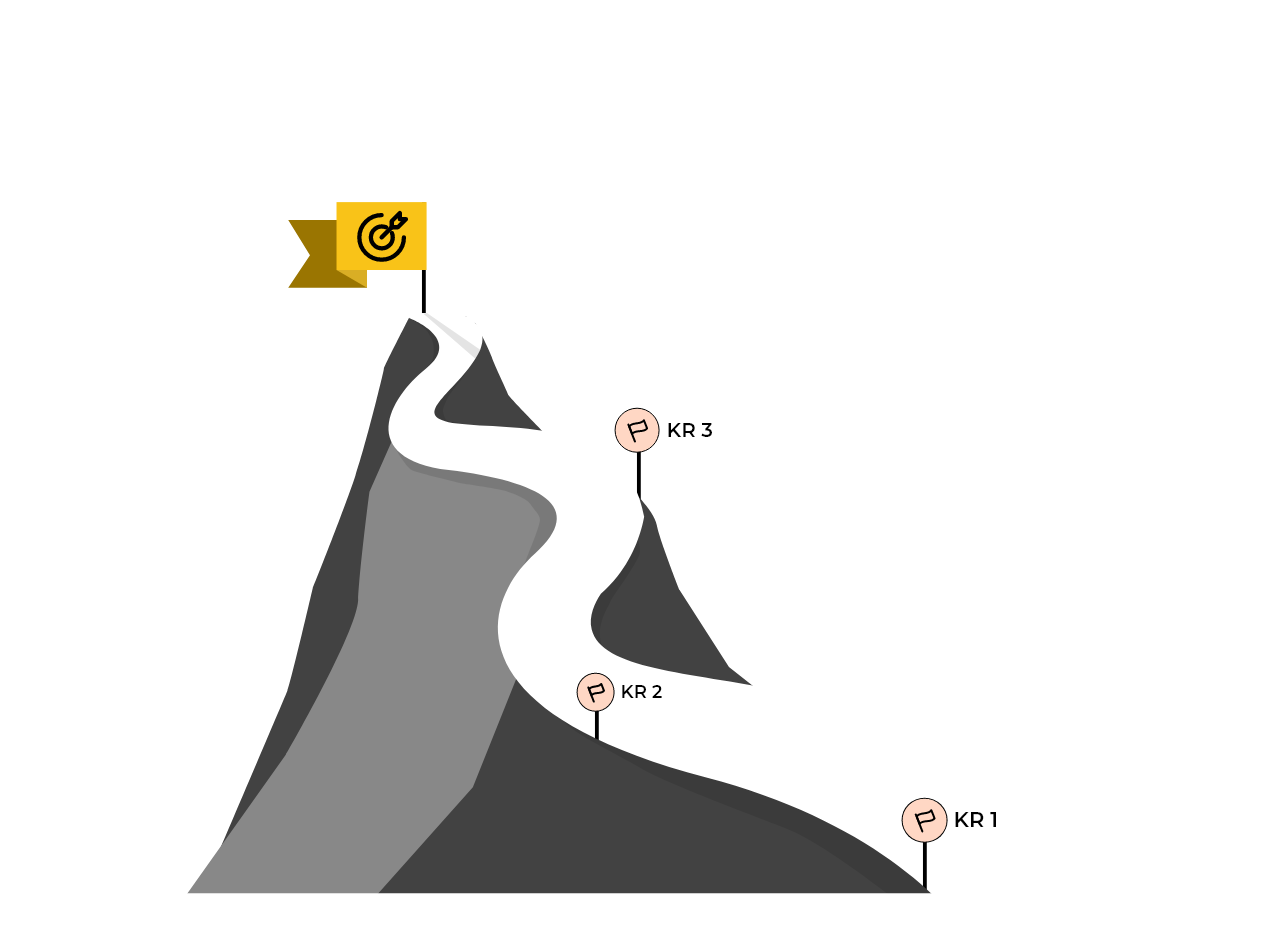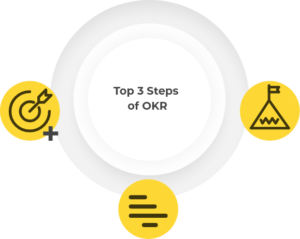Objectives and Key Results
Do you need to focus, plan, and measure success for your organization? There’s no better tool than OKR. Whether you call them objectives and key results or outcomes and KPIs, they bring structure to how teams reach their goals.
In this OKR implementation guide, we will walk through each phase of the OKR cycle – from setting baseline goals and expectations to monitoring progress towards those targets – so that your organization can reach its highest potential. So let’s get started on our journey to mastering OKR cycles today!
Step-by-Step Guide to OKR
What is an OKR?

Setting and achieving objectives is at the heart of every successful startup. The OKR planning provides an effective framework for startups to do so, but it is important to understand two key elements for it to work effectively. Firstly, aligning vision and goals across the entire organization is crucial to success; all members sharing the same vision and working together is what will make the vision achievable.
Secondly, startups need to adopt a flexible attitude in order to cope with any dynamic situation that may arise along their journey. Being able to take stock of their experience and make changes accordingly helps them stay on track and builds greater confidence in the organization overall.

What is an Objective?
An objective in OKR (Objectives and Key Results) is a specific, measurable, and time-bound goal that an organization, team, or individual wants to achieve.For example, an objective for a marketing team could be:
Objective: Increase brand awareness among target audience.

What is Key Results?
A Key Result (KR) is a metric or measure that tracks progress towards achieving a specific objective in the OKR (Objectives and Key Results) framework.
An example for KR is given below.
Objective: Improve customer satisfaction in the retail sector
Key Result: Achieve a 9 out of 10 rating on customer satisfaction surveys by the end of Q3

What are initiatives?
Initiatives in OKR (Objectives and Key Results) are a series of actionable tasks or projects that support the achievement of an objective. They are the specific steps or activities that need to be taken to reach a desired outcome.

For example, let’s say the objective is to increase sales by 20% in the next quarter:
Initiatives to achieve this objective could include:

Launching a new product line

Implementing a targeted marketing campaign

Offering promotions and discounts to customers

Improving the customer experience
Success Stories of OKR

The concept of Objectives and Key Results (OKRs) was first introduced by Intel co-founder and former CEO, Andy Grove. John Doerr, a former Intel employee and venture capitalist, later introduced the approach to Google, where it was adopted with some modifications to fit the company’s needs.
Since then, OKRs have been adopted by a number of other companies such as Amazon, Twitter, Spotify, and others, with each organization making their own adaptations to suit their specific requirements.
Benefits of OKRs
A vision and mission statement sets the direction and purpose of a company. They provide a clear understanding of what the company is trying to achieve and what it stands for. When a company aligns its goals and objectives with its vision and mission, it can achieve a greater sense of purpose and direction.
In the context of OKRs (Objectives and Key Results), a vision and mission statement can provide a clear framework for setting and prioritizing objectives. For example, the objectives set in an OKR framework should align with the company’s overall vision and mission. This helps to ensure that all efforts are directed towards achieving the company’s goals and purpose.
For example, Tesla’s vision to “create the most compelling car company of the 21st century by driving the world’s transition to electric vehicles” can guide the setting of objectives and key results to support the transition to electric vehicles. Similarly, Salesforce’s mission to “empower companies to connect with their customers in a whole new way” can help towards the devsing of OKRs that support customer success.
In the same way, the vision and mission of 10xWinners to be the market leader in OKR platform and help organizations grow 10x faster can assist in the rollout of OKRs that resonate with its mission and vision.
How to choose an OKR Cycle?
When considering which OKR cycle to choose, it is advisable to employ the dual cadence strategy. This means turning to a combination of quarterly and annual OKRs to gain the full value of both.
Top 3 Steps of OKR

Here are the top three steps of a typical OKR strategic planning cycle.
Create
An effective OKR process starts with the creation of high-quality objectives and key results. They should not be confused with daily tasks but must be empowering and enable measurable progress.
Align
Ensuring the alignment of OKRs is an ongoing process that requires mapping out the relationship between teams and the organization they are part of. This can be achieved through thorough conversations concerning OKR proposals and objectives between team members and their respective managers.
Achieve
When considering which OKR cycle to choose, it is advisable to employ the dual cadence strategy. This means turning to a combination of quarterly and annual OKRs to gain the full value of both.
Typical OKR Cycle
Let’s next explore a typical OKR step-by-step cycle.
Yealy OKR Planning: 4-6 weeks before the end of the year
During the closing few weeks of the year, leaders should start working on their plans and objectives for the new year. This is the time to devise yearly plans, set key OKRs for the first quarter, and chart out a course of action for the company to take.
Quarterly OKR Planning: 2-3 weeks before the quarter ends
With just a couple of weeks left before the year ends, now is the time for any startup to decide on its organizational objectives for the coming year and quarter. These objectives must be communicated to all staff across the company, to ensure everyone is working towards a shared goal.
During the quarter
Unlike traditional goal-setting methods, with OKRs it is possible to address any potential problems as they arise, ensuring progress and momentum toward achieving the key objectives. This not only ensures goals are met but motivates teams to stretch and look for even more ambitious outcomes.
Review Cycle: one week after the start of the quarter
The frequent review cycle of OKRs fosters a culture of transparency and creates alignment across departments, so everybody takes responsibility for their parts of the bigger picture.
Engagement: Throughout quarter
By continuously engaging in this ongoing process and quickly changing course when needed, teams can identify their performance gaps early and adjust strategies accordingly to ensure successful outcomes.
Cadence Review: Near the end of the quarter
As the quarter draws to a close, a review of individual and team OKRs for the past period is an essential part of our success planning. Objectives provide us with focus and purpose throughout the quarter, so taking some time to assess how we perform against them at the end will help us uncover valuable insights for improvement. There are many quarterly OKR examples which has helped organizations thrive and meet business goals.
How to Set and prioritize OKRs
Creating effective OKRs (Objective and Key Results) is a highly effective way of setting and achieving goals. The first step in the process is to define the Objective, which should be a clear statement that describes the goal. Once an Objective has been created, it’s important to identify relevant Key Results that reflect measurable success relative to that Objective. These should be measurable results with achievable targets, as well as an agreed-upon timeline for meeting them.
Setting organisation OKRs
The whole practice of setting organisational OKRs differs greatly for different industries. Many organisations fall prey to the common pitfall of attempting to integrate the OKRs of other industries and fail miserably in achieving their end objectives. Startups, Fintech, tech and other domains should invest considerable resources and time to research out the best OKR practices that can align well with the organisational mission and vision.
Setting Departmental / Teams OKRs
Team OKRs and departmental OKRs should ultimately reflect the organisational OKR. They can be expanded on a quarterly basis as per the requirements of individual workplace settings. All departments/teams should focus on their part to support the organization to achieve the organization OKRs.
Set Priority
Following a priority as given below can help departments and teams achieve the KRs faster within the deadline.
P1: If the task is important and urgent
P2: If the task is not important but urgent
P3: If the task is important but not urgent
The task needs to be dropped if it is not important or urgent.
OKR Types and Measurements
Let’s next get into the different OKR types and their measurements.
Aspirational OKRs
Aspirational OKRs (Objectives and Key Results) provide a framework to measure progress toward ambitious, long-term goals.
Committed OKRs
Committed OKRs, or Objectives & Key Results, are a strategic planning methodology used by organizations to set and track progress toward specific goals.
OKR Tracking and Monitoring
You can use the following ideas to regularly track and monitor the progress of your OKRs.
Regular Check-ins
Checking progress throughout the cycle not only keeps teams aligned, but also ensures that objectives stay top of mind. Establishing weekly reviews will allow teams to address any issues or uncertainties before they become serious problems.
Confidence ratings
Taking time to reflect on confidence during an OKR cycle can be beneficial when it comes to improving confidence ratings.
Test, learn, and adapt
To ensure that projects reach the desired conclusions, it is important to consider what was effective during the sprint and what didn’t work as planned. After incorporating these findings into future strategies, teams will be more mindful of their decisions.
Why do many OKRs Fail?
Here are some of the reasons why even the most well-planned OKRs fail despite adopting an OKR step by step process.
You set bad OKRs
Too often, companies focus on ‘vanity metrics’ that measure successes that in reality do not add anything meaningful to the business’s bottom line. An effective OKR execution should include measurements of success that are objective and measurable.
No Leadership Commitment
Without strong leadership commitment, OKRs become more symbolic than practical and don’t help drive measurable results. The problem is that without this commitment, it leaves everyone confused about what matters most to the company and how best to achieve its objectives.
Lack of Communication
Without regular dialogue, collaborative effort, and clear objective-setting goals, objectives can become vague, irrelevant, or outdated and there will be no clear path forward known to the teams involved.
Too many objectives
Setting too many objectives in OKRs can cause them to fail because it can be difficult and demoralizing for employees to focus on multiple goals at once.
Lack of proper tools
Without proper tools, it’s difficult to evaluate whether or not employees are meeting their objectives regularly and properly measure progress over time. Consider digital transformation in your organization for better measurements.
How to optimize your OKR?
An integral part of creating a successful OKR cycle is understanding the steps for OKR success. Getting even one variable wrong can prevent you from seeing the full potential of your goals. To make sure you are aligning with best practices, consider working with an OKR consultant who can guide you through the different phases of the cycle and put in place a robust plan tailored to your organizational needs.
Performance Conversations
Performance conversations related to OKRs are an excellent opportunity for employees and their managers to take the time to review progress and discuss any successes or challenges. With the ability to focus both on short-term achievements and long-term goals, this kind of conversation encourages open dialogue about objectives and performance.
Final Thoughts
Implementing OKR steps can be daunting, but it doesn’t have to be. By understanding the steps, phases, and best practices of setting up an OKR system, you can ensure that your business is on track for success.
And if you need any help along the way, you can use our OKR tracking software. Our team at 10xWinners is always here to lend a hand for your queries on organizational goal setting. We offer tailored software solutions that make it easy to track your OKRs and measure progress against milestones.
Contents
